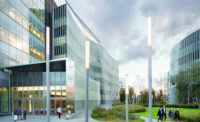Duarte, California
The first time architect Hagy Belzberg visited City of Hope (CoH), a biomedical research and treatment center for cancer and other life-threatening diseases, he was drawn to four young “Wishing Trees,” fluttering with colorful paper rectangles. Each of those tags, strung from the branches like tiny prayer flags, carried a thought, a hope, a message from a patient, a family member, or a friend. “It moved me profoundly,” recalls Belzberg of the borrowed Japanese tradition that began here three years ago and quickly blossomed.
But later, when Belzberg strolled the campus, he came upon a majestic tree with a tremendous canopy. “It connected back to the Wishing Tree narrative,” he recalls. “And I thought, 'Why not make the site right here, under and around this amazing tree?” Intuitively he could imagine drawing researchers out of their labs, beyond institutional and hermetic confines, to exchange ideas in a natural gathering place.
As he later learned, that tree was a particularly apt symbol for CoH's century of growth: it was 100 years old and probably planted when the organization first put down roots; also it was a camphor, an Asian tree known for its medicinal uses, longevity, and recovery. (Famously, in Japan, one specimen has an estimated age exceeding 1,000 years and, after the atomic bombing in Hiroshima, others sprang back with remarkable speed and health.)
Belzberg soon convinced his client to build alongside the great camphor. Beyond its evocative power—as a tree of knowledge, tree of life, tree of hope—it represents the nexus of CoH's historic grounds and later expansion. It was also, as Dr. Friedman points out, “at the emotional center of campus, surrounded by buildings with the highest traffic and greatest concentration of treatment and research facilities.” And constructing the project here from scratch opened up potential for an intimately scaled indoor-outdoor venue, an antidote to the institution's larger, more formal enclosed conference settings.
To embrace the open space beneath the tree's canopy, Belzberg Architects (BA) designed a single-story structure on either side of it, together comprising the 7,000-square-foot Kaplan Family Pavilion. In each, a glassy vestibule, like a hinge, joins two programmatic elements: a flexible 1,745-square-foot assembly room and a large catering kitchen in one and, in the other, a 1,545-square-foot exhibition space with its own administrative offices. And where the pavilions face the shady camphor, their rectangular volumes melt into curvy organic form, as if responding to energy fields of the tree, an impression accentuated by the convergence and divergence of grid lines on the structures' concrete skins.
“The tree is the emphasis and the threshold,” says Belzberg. From beneath its leafy canopy, you enter each building by slipping between two walls. There, a concrete rainscreen pulls away, like a billowing drape, from the underlying concrete or weathering steel cladding. The rainscreen morphs into seating against each facade, and a concrete bench—like a dynamically stretched torus—rings the big tree.
The bench, however, does not touch the trunk and barely meets the ground. The entire project's design and construction took great care to protect the tree, as BA sited the pavilions as close to the camphor as possible without encroaching on roots or branches. (The resulting challenges in accommodating foundations and seismic bracing were resolved with Nous Engineering.)
Ahbe Landscape Architects, which had worked with CoH on many earlier projects, designed the Kaplan's grounds. “Here we kept it very simple and serene, using native grasses instead of ornamental plants or flowers, to set off Hagy's sculptural forms and their refined but simple materials.”
The $8 million project opened in February and is on track for LEED Platinum certification. The gallery's rotating exhibits—to correlate with symposia in the pavilion—await installation, but 100 backlit acrylic plaques already glow across the concrete skin of both buildings. Half of these insets commemorate CoH's historic moments and breakthroughs, including the synthesis of human insulin in 1978. The remaining 50 are blank, ready for future milestones.
Already conferences here have spilled productively outdoors as the assembly room—with a sliding-glass rear wall—opens to lawn and patio, and attendees informally extend their dialogue beneath the tree. These areas, near the catering kitchen, will host future graduations, open-air receptions, and dinners.
Although meditative and healing gardens weave through CoH's campus, an unexpected consequence of the Kaplan Pavilion has been its draw not just for faculty and staff but also for patients and their families, often seen gathering under the great camphor. In its gentle, nourishing, and contemplative connection to nature, the spirit of this new center seems to resonate with CoH's underlying credo: “There is no profit in curing the body if, in the process, we destroy the soul.”
PeopleClient: City of Hope Owner: City of Hope
Architect:
Personnel in architect's firm who should receive special credit: Project Team: Andrew Kim, Ashley Coon, David Cheung, Cory Taylor (Licensed Architect), Susan Nwankpa, Micah Belzberg, Chris Sanford, Kris Leese Architect of record: Hagy Belzberg, FAIA Interior designer: Belzberg Architects
Engineers:
Consultant(s):
Other:
Photographer(s): Size: 7,000 square feet Construction Cost: $6 million Project Cost: $8 million Completion date: February 2015 |
Products
Structural system
Exterior cladding Precast concrete: Meridian Precast – Exterior precast concrete building panels Wood: Tounge and Grove Cedar Soffit by Contractor. Dark transparent stain
Roofing
Windows
Glazing
Doors
Interior finishes Suspension grid: Armstrong Paints and stains: Dunn Edwards Special surfacing: Cast in Place undulating concrete feature walls at courtyard
Floor and wall tile: Special interior finishes unique to this project: NewMat stretch ceiling – Graphic Light diffuser at Assembly Room.
Plumbing |













